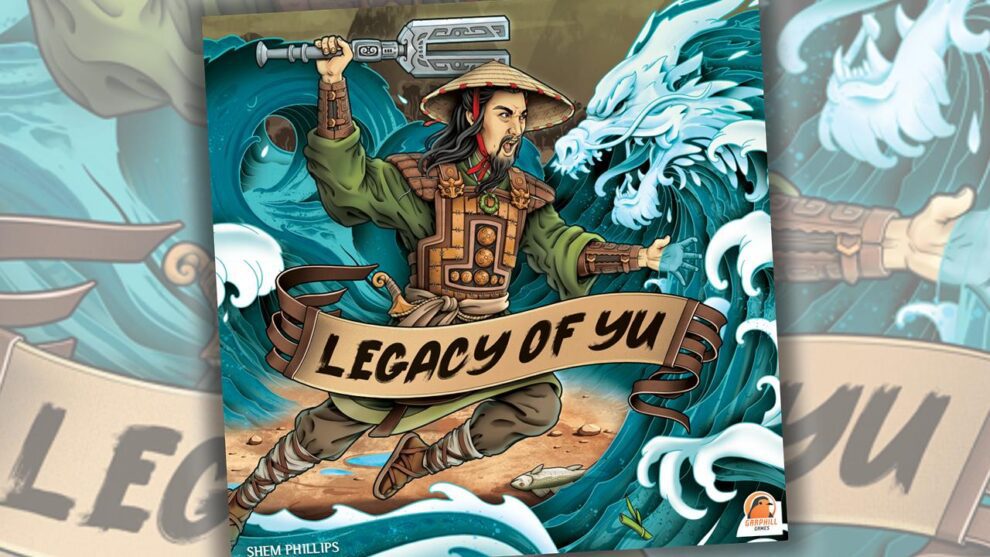Disclosure: Meeple Mountain received a free copy of this product in exchange for an honest, unbiased review. This review is not intended to be an endorsement.
Part of the Reluctantly Solo series
Gaming is a social time for me. The interactions of the people, the discussions before, after, and during the game, the appreciation for a good move—and the laughter that often accompanies it—all combine to make a good gaming session a great one.
Due to recent health issues, I can’t drive, walk, or even stand, without being in I-need-to-sit-down-right-now pain. My weekly gaming group has, thankfully, moved online for the next few months (thanks BGA and Steam!), but I still get a regular urge to play a physical game.
Hence, the Reluctant Solo series was born.
First up: Shem Phillips’ 2023 solo-player game, Legacy of Yu.
Wake of the Flood
During the time of Emperor Yao, the annual floods from the Yellow River inundated the people of China. Yao chose one of his officials, Gun, to design a plan to tame the wild river. Unfortunately, his dikes and dams would not hold. Nine years later, the Emperor dismissed Gun and the task of managing the river was passed down to Gun’s son, Yu.
Having learned from his father’s failures, Yu devised a series of canals to divert the flood waters into nearby farmlands. Now, you—as Yu—must coordinate villagers and workers to gain the resources needed to build those canals.
As if that wasn’t challenging enough, you must also defend your village from the raiding barbarians who attack in ever-greater numbers. If you cannot defeat them, you’ll need to bribe them to leave your village alone for the day.
A full run of Legacy of Yu is played over seven seasons (or games), with campaign elements added at the end of each game based on whether you won or lost that session.
As you play, you will uncover parts of the deeper story of Yu through cards that will direct you to read specific sections of the Story Book. These act as the Fates, sometimes aligning with your cause and sometimes at odds with your plans.
To win, you’ll need to build all six canals and fend off a final round of Barbarians. Of course, there are multiple ways to lose. Those villainous Barbarians will attack and attack, chasing the helpful Villagers from their spaces along the top of the board. If the Barbarians fill all those spaces, you’re dead. If you’ve chosen to bribe them instead of fighting them, you may be ask to destroy a Villager (by putting their card back in the box). If you have an available Villager card in your deck, you’re fine. If not, you lose.
Oh, and remember that whole flood part of the story? If the flood ever passes over a Canal you haven’t built yet, you’re both dead and dishonored.
Let’s get Legacy of Yu to the table, shall we?
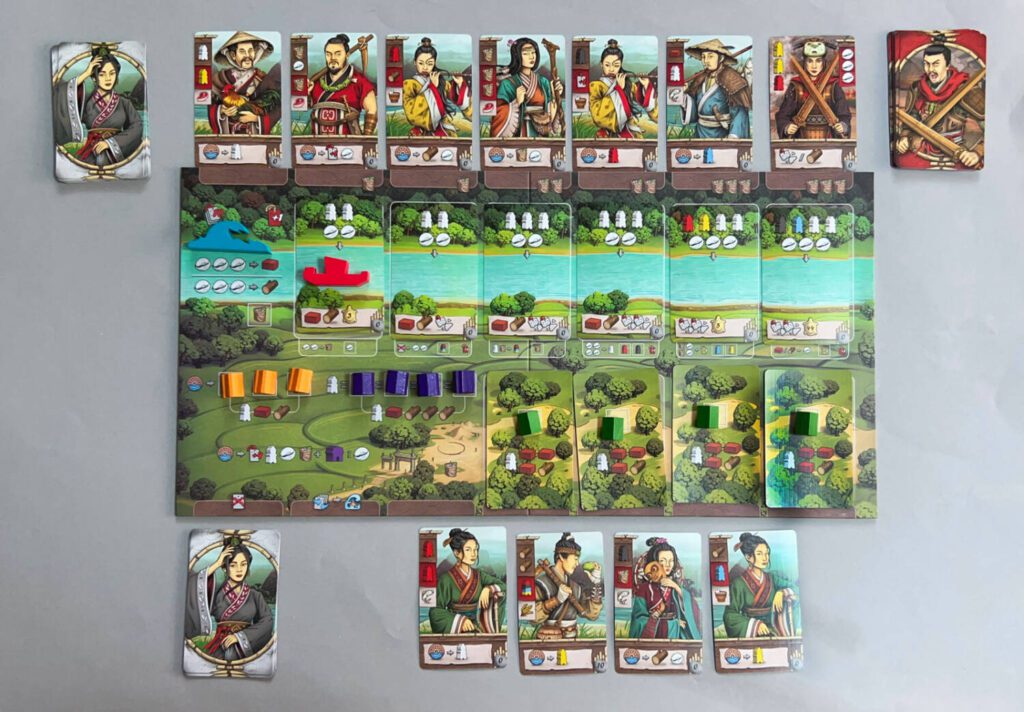
Laughing Water
The game board has six spaces for Canal cards and you’ll randomly choose from the ten available cards to fill those with face-down cards.
Do the same with the Hut cards, placing four of these face-down in the spaces at the bottom of the board.
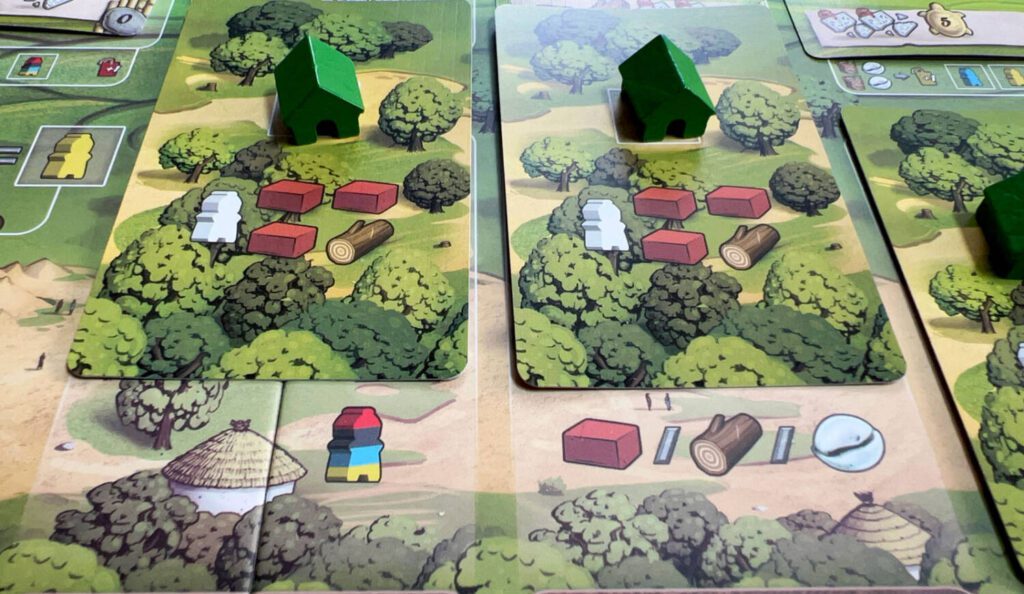
Place three Farms…
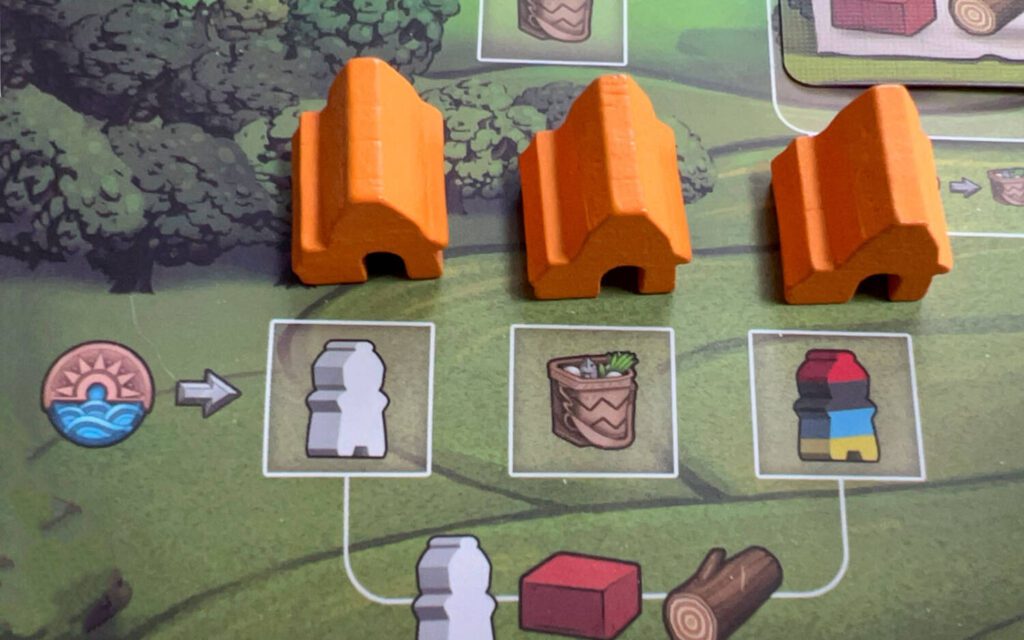
…four Outposts all in their respective places on the board.

Shuffle the Barbarian cards and place one in the top right space above the board. Then shuffle the Villagers cards, dealing your ten starting Villagers below the board and six along the top. Set the resources (Cowrie shells, Wood, Clay, and Provisions) to the side. Do the same with the set of five colored worker Meeple. Place the blue Wave token on to the far left of the Canal cards and the red Canal marker on the first Canal card.
Line Up a Long Shot
At the beginning of each round, you take the resources shown on the board. At the start of the game, this will be one White worker, one Cowrie shell, and one Provision. You’ll also shuffle your ten starting Villager cards and deal four of them face-up in front of you.
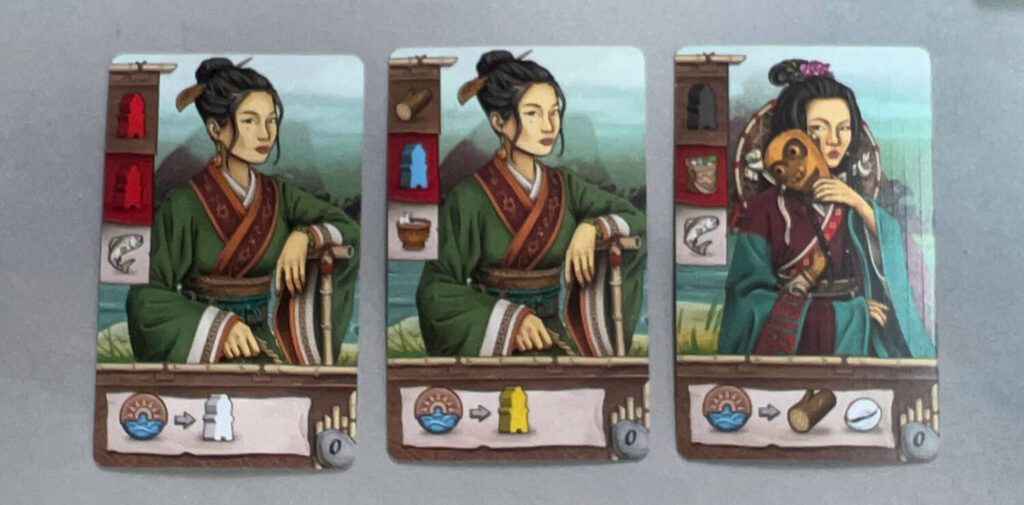
After collecting your resources, you’ll start taking actions. Actions all require resources or workers, meaning you’ll always be lacking the proper resource/worker throughout the game. In order to gain more resources, you’ll need to use one of your Villagers for the item shown in the upper left corner of their card. These can range from extra standard resources or specifically colored workers. (Workers come in white, red, black, blue, and yellow.)
You can also claim the Villagers at the top of the board by paying the cost in Provisions (1-3) below them. The Villager to the far left is always free, so be sure to take that one before planning out the rest of your round.
Every round will be a new set of decisions as you prioritize the things you want to do:
- gain extra resources at the start of a round
- gain flexibility in the colors of workers needed
- add to your available deck of Villagers
With the things you must do:
- defeat Barbarians
- build the Canal
Gain Extra Resources at the Start of a Round
You can gain additional resources at the start of each round in several ways. At the bottom of the board, there are spaces underneath the Hut cards where you can tuck cards to show their start of round bonus. The first space is free, but the others require a White worker, three bricks and a wood. (Not cheap!) After building a Hut, you get a new space to place a worker to claim a specific provision. These spots are nice because, unlike other worker placement locations, you get your Hut workers back at the start of the next round.
Gain Flexibility in the Colors of Workers Needed
Paying a White worker, one brick and three wood allows you to build an Outpost. This has two benefits: first, you’ll gain an extra Cowrie shell at the start of each round. Second, you’ll be able to substitute a White worker for a colored worker of your choosing. I’ve found this is very helpful when defeating Barbarians.
Add to Your Available Deck of Villagers
Your deck of Villagers (10 cards) is how you keep track of rounds. Each time that deck runs out, it triggers the start of a new round. Although this sounds good (new resources!) each round increases the Barbarian threat level and moves the flood one space to the right (not good!).
The Villager cards can be used in one of two ways. You can either gain the resource in the uppermost left corner (brown background) and place it in your used pile of cards or you can ‘exhaust’ the card to get both resources in the top left (brown and red backgrounds). However, when you do so, you’ll place that card back in the box for the rest of this session. Just remember, running out of cards automatically loses the game.
The Villagers you add from the top of the board are either placed face-down in your ‘exhausted’ pile or can be removed from the game to immediately get both resources they offer.
Defeat Barbarians
The Barbarians will be a constant pain for you to deal with, so they deserve a closer look. In the upper left of each Barbarian card are the number and colors of workers needed to defeat it and remove it from the game. (You’ll also need to pay the Provisions listed under the card to attack.) If you can’t defeat it, maybe you can bribe it by offering the provisions/workers in the upper right. This leaves the Barbarian in place, but avoids its attack. If you can’t do that, the price of the attack is shown at the bottom of the card.
When you defeat a Barbarian, you’ll gain the resources shown in the upper right of the card.
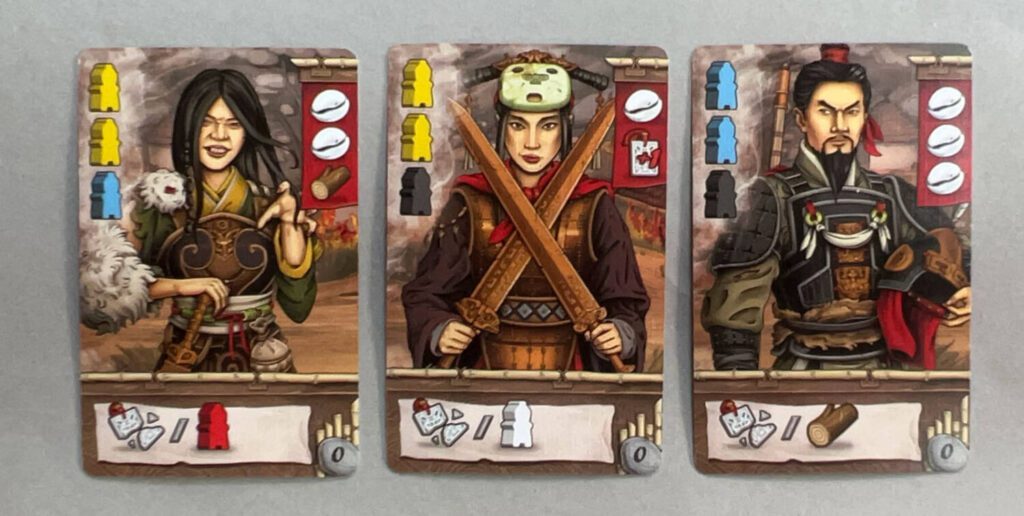
At the start of the game, you have one Barbarian in the upper right corner. That’s because there is a single small red card with a +1 showing on the board. (Below the Villager card on the far left.) This means at the start of each round, you’ll add 1 Barbarian to the top row. If you fail to defeat that lone Barbarian before the round ends, you’ll move him down and draw +1 Barbarian and place it to the right of the first Barbarian.
This might not sound too bad, but consider that half of the Canals you complete add an extra Barbarian to the top row. Instead of adding 1 Barbarian card, you’ll be adding 2 or 3 cards at the start of each round. This not only lessens the number of Villagers you can enlist, but pushes you closer to defeat by having that top row filled with Barbarians.
Build the Canal
Speaking of the Canal, running out of your personal deck of Villagers not only triggers the start of a new round, but it moves the flood one space to the right. If you’ve built that Canal by paying the costs shown on the leftmost card (2 White workers and 2 Cowrie shells for the first four Canals), you’ll be fine. If not, you immediately lose the game.
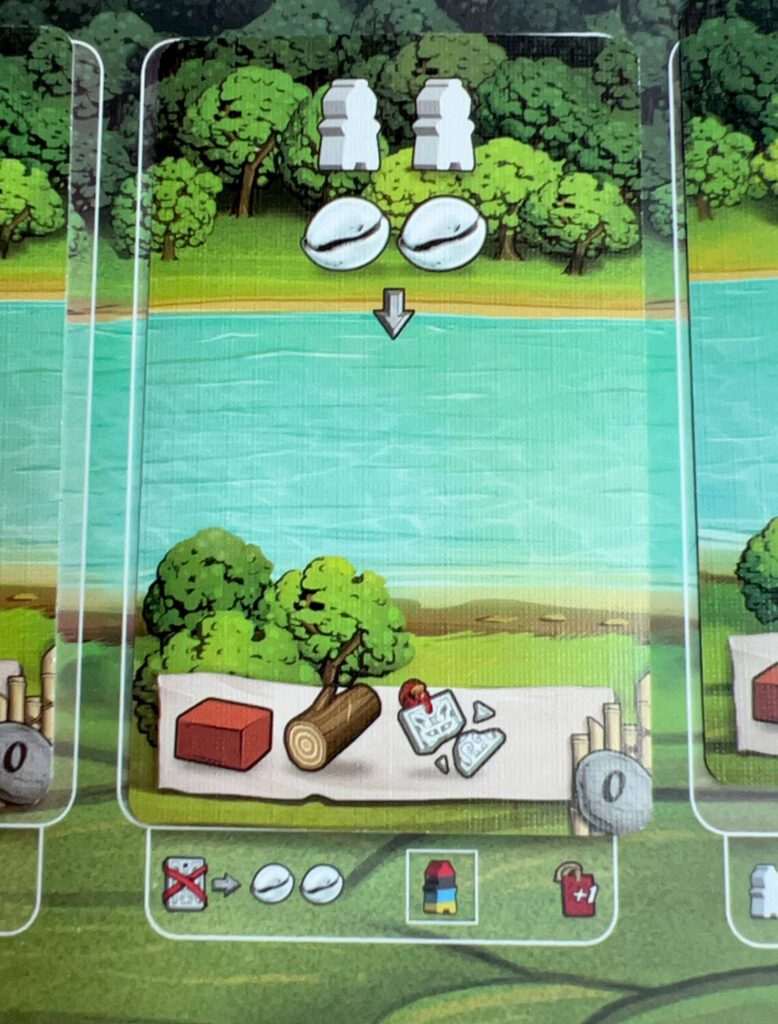
Building a Canal will expose new trading options. At the start of the game, you’ll be able to trade 3 Cowrie shells for a single brick or wood. When you build the first Canal, you’ll be able to trade 2 Cowrie shells for a Provision. You’ll quickly find these improved exchange rates to be very helpful.
Asking You Nice, Now
As the name suggests, Legacy of Yu comes campaign elements—all of which can be reset to start a new series of games or when you lend the game to a friend. They make each series of games feel different, like a different retelling of an old folktale.
Adding the legacy changes happens when one of two icons appears: the golden turtle and the gray rock. The golden turtle will instruct you to open the Story Book and read a certain, numbered passage. The gray rock will have you go through the Story deck of cards and pull out a specific numbered card. You will do this only when indicated, although that can come at various points during the game. Each individual game you play, win or lose, will also point you to both of these.
Since I am very good at losing Legacy of Yu, I have had more experience with the “Aw, you lost? Here, let me make the game ever-so-slightly easier for you” side of these elements.
Being intentionally vague to avoid spoilers, I have added some helpful Villager cards (that I may or may not see depending on the shuffle) and read Yu’s heartfelt letter to his wife concerning his failure. Another card adds a new task to winning that game: you must use three Villagers to solely to provide the food listed on the bottom left of their card (one each for fish, meat, and water). Three Villager cards may not sound like much, but this is a Shem Phillips game. That means all resources are tight.
Here Comes Sunshine
I love this game.
Despite not winning, Legacy of Yu is a solo game worthy of the best of Phillips’ games. All the elements are here: provisions, workers, multi-use cards, and every turn filled with the crunchiest of decisions.
When I first opened the box and looked at the components and the board, my first thought was, “This looks like it could be a smaller version of Paladins of the West Kingdom.” Luckily, I love Paladins, and while that assessment doesn’t bear close examination, there are similarities.
There are good reasons for wanting to do All the Things, but you only have the time and resources to do a few of them. The constant pressure of building the Canals and fighting off the Barbarians has forced my attention/resources there, leaving other resources to support those efforts. There is no downtime in Legend of Yu. You’re confronted with multiple urgencies in every turn.
It’s easy to be lulled into a false sense of security on your first turn, seeing that row of six Villagers, all willing—no, wanting—to lend their assistance to your cause. To defeat that first Barbarian you’ll need colored workers you likely won’t have access to yet and three spare provisions you’ll want to use to add some of those Villagers to your personal deck.
After that first round, that Barbarian slides to the left and you have one fewer Villager to enlist. No problem, you say. Besides, I’m running short of cards in my personal deck so I have to build the first Canal. And then the second Canal—only that second Canal now means two Barbarians come out at the start of each round. And they don’t replace the Barbarians already muscling in on the top row of the board. Oh, no. Every round, two more Barbarians enter that row. Then you’re stuck prioritizing building Canals with fighting off Barbarians.
Build the fourth Canal and three Barbarians get added at the start of each round.
And I love it.
I am not a glutton for punishment, but I do love having to make deeply strategic choices now that will affect the rest of my game. Given my win/loss record with Legacy of Yu, I’m clearly not very good at it, but that doesn’t stop me from enjoying the challenge.
If you like Shep Phillips’ games and would like to test yourself in a solo game, do yourself a favor and get a copy of Legacy of Yu. It is so, so good.


